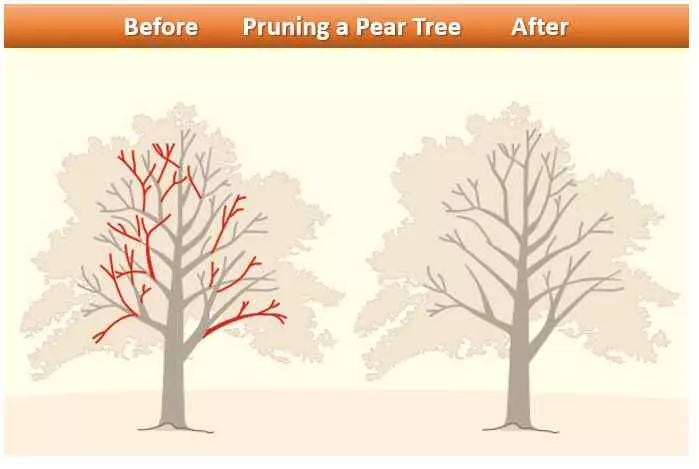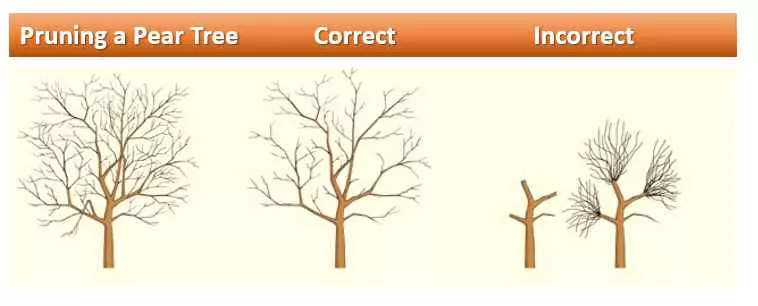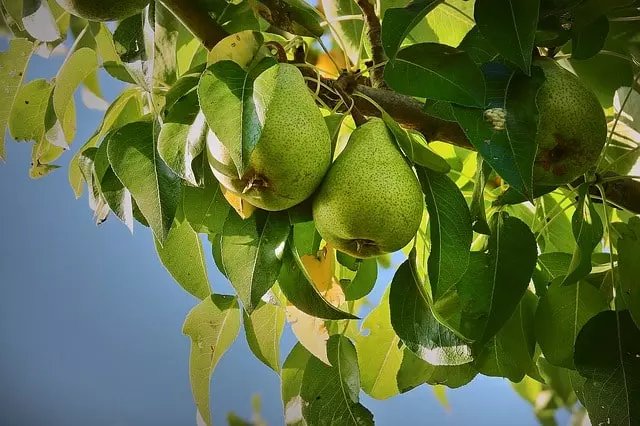The common pear (Pyrus communis L.) is a plant native to central and eastern Europe and southwest Asia. It is a plant that can reach 65.6 ft (20 meters) in height, pyramidal in shape in the early years, and tendentially globular at maturity. Pruning is not simply cutting branches for aesthetic purposes but is much more than that since this technique can be used to modify the sap flows of the branches themselves. Our gardener experts will guide on How to Prune a Pear Tree and solve inconveniences when pear production is decreasing due to incorrect previous pruning. How to perform the regeneration pruning to regrowth the prune tree.
The raw sap favors the development of the upper part of the tree during the vegetation periods while the elaborated sap (full of sugar) is concentrated in the branches with lower orientation. Well, having clarified this, we will say that in seed trees we will carry out dry pruning during the vegetative rest periods, that is, in the middle of winter. However, in bony trees, we will prune during the summer, in the middle of the vegetative process.
When we talk about types of tree pruning we can distinguish two main classifications:
- Formative pruning of young trees.
- Pruning of adult trees.
To prune the pear tree we recommend these tools (Order it here). If your pear tree has very thick branches, you will also need this tool (Order it here). Always before using the tools to prune the pear tree we must disinfect them properly with alcohol.
Table of Contents
Pruning a Pear Young Tree
In the following paragraphs, our experts have summarized for you the tips to keep in mind to know how to prune a pear tree when is a young tree and increase pear production. It is essential to carry out an adequate pruning of young trees to avoid having to make large cuts later that will be difficult to close.
In general, two large groups of trees can be distinguished according to the stem and structure formation pruning systems used. On the one hand, the group of trees with a single dominant or guide stem. On the other hand, the group of trees with a cross crown (with the main trunk and at a certain height across, from which the main branches start).
Pruning is not difficult and the goal is to create an open canopy shape from five main branches. Winter pruning is used primarily on pear and apple trees grown as trees. Restricted forms such as espalier crops and other variations are managed with summer pruning, although winter pruning is initially used to shape them.

The appropriate time for pruning is while the tree is dormant, throughout the winter and a few weeks before spring. It will depend on quite a bit on the geographic location where the trees are located. Use good, clean-cutting tools.
Even applying a disinfectant to cutting blades beforehand will not hurt. Start by removing crossed, weak, diseased or dead branches.
Keep the center of the tree open, if it is necessary to prune several thick branches we will space it in time. In two or three winters so that the tree does not suffer excessively. Cut branches that have grown too much upwards, close to a lower branch with a diameter of at least one-third of the branch being removed.
The evolution of the forms of cultivation in the pear tree has gone from volume forms such as the vase to the early and irregular to the spindle, then the main axis with branches of exploitation, to the vertical cordon and the V-shape.
When to Prune a Pear Tree
In the following paragraphs, we explain the best time to prune a pear tree without affecting fruit production. Continue reading to Learn here How to Prune a Pear Tree and Increase Pear Production.
Apple and pear trees should be pruned each winter to ensure a good fruit crop the following season. Trees that are not pruned become less productive as they have too many branches to feed.
Like most fruit plants, Pear trees should be pruned in the period corresponding to the vegetative rest, so in the autumn and winter season.
In addition, since it is good not to let the freshly cut parts be damaged by winter frosts, it would be advisable to prune just before the growing season, which corresponds approximately to February. However, pear trees are hardy trees and can also be cut back in autumn, from November to early March.
Breeding pruning is that serves to orient the plant towards the chosen form, it is carried out from the moment of transplanting for the first period, while after three or four years the plant will be formed and will go on to pruning that has the purpose of regulating production and not only to maintain the shape of the plant.

As mentioned in the forms of cultivation, the pruning of pear trees depends on the form chosen.
On the other hand, green pruning has the task of balancing the relationship between vegetation and fruiting of the plant, so this technique consists mainly of removing the parts that absorb energy from the plant without bearing fruit. It also allows you to reorganize the balance of the foliage, eliminating offshoots and removing excess branches.
Shorten the previous year’s growth on each main branch by about one-third to the bud located facing the precise direction in which you want the tree to develop. Cut back young lateral branches growing on the mainframe to five or six buds if there is not enough room for them to grow as secondary branches. Cut off all shoots that grow out of the main design. On older trees remove branch systems that have grown too close together.
Two pruning schemes, the upper one shows the pruning needed for a mature tree that produces most inside the branches, it will be a tree with many bags and branches. In the lower scheme when the tree’s production is centered at the tip of the branches.
Regeneration Pruning
This pruning is not done regularly but in specific cases. For example, when we notice that our fruit production is decreasing.
Regeneration pruning is aimed at the regrowth of the fruit tree and is widely used in olive, apple, quince, or pear trees, but not in plum, peach, or cherry trees.
The types of pruning in fruit trees mentioned in this article are the ones to be used by any horticulturist, who must know how to distinguish which type of pruning to apply to each species and at each moment.

